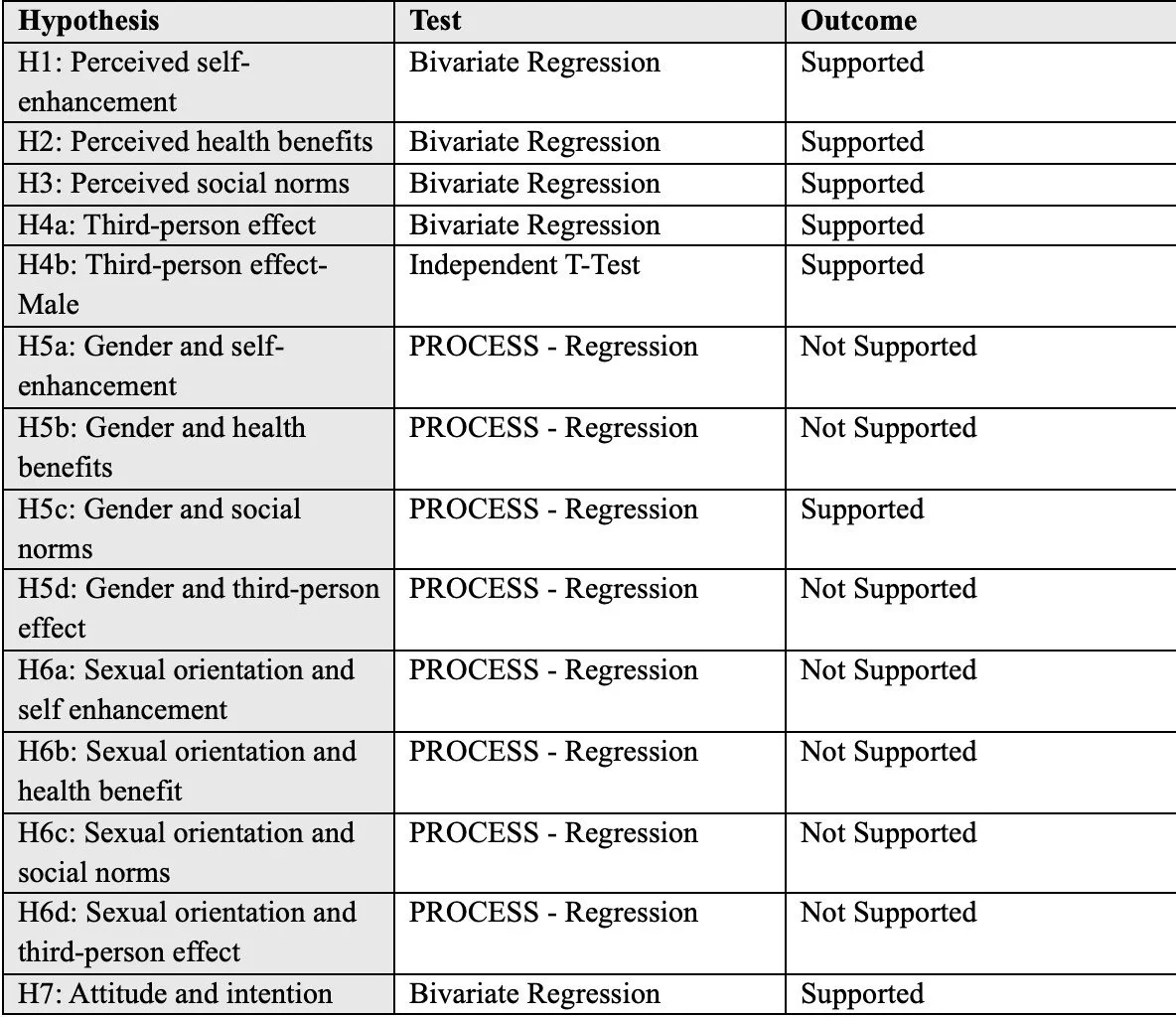
The Rise of Social Media Fitness Trends and Their Impact on Young People’s Attitudes and Intentions to Engage in Fitness Activities.
Abstract
This dissertation explores the impact of perceived self-enhancement, perceived health benefits, perceived social norms, and the Third-Person Effect (TPE) on U.S. college students’ attitudes toward social media fitness trends and their intention to engage in fitness activities. This study is built on the foundation of the Theory of Planned Behavior (TPB) while also incorporating the TPE, revealing its impact on attitude. This research also examines gender and sexual orientation as moderating variables. Lastly, this study explores gender differences in the influence of the TPE.
A quantitative research design was employed using an online survey that generated 148 valid responses. Bivariate regression analyses were used to measure the impact of perceived self-enhancement, perceived health benefits, perceived social norms, and TPE on attitude. Gender and sexual orientation were measured through a regression analysis using Hayes’ PROCESS model, and the effect of gender on TPE was analyzed using an independent t-test.
Results indicated that attitude was a significant predictor of intention. Furthermore, perceived self-enhancement, perceived health benefits, perceived social norms, and TPE significantly impacted attitudes toward social media fitness trends, with all variables showing a positive effect except for TPE, which had a negative impact. Among all the factors analyzed, perceived social norms were the strongest predictor of attitude. Results also found that gender moderated the relationship between perceived social norms and attitude, with the effect being stronger among females than males. Lastly, the analysis of TPE revealed that male college students perceive others as being more influenced by social media fitness trends than themselves, indicating a strong TPE that ultimately negatively impacted their attitudes.
This dissertation discusses these findings in detail and outlines important implications, limitations, and directions for future research.
Hypothesis Development and Conceptual Framework
Primary Relationships (H1–H3)
Third-Person Effect (H4a–H4b)
Moderation by Gender (H5a–H5d)
Moderation by Sexual Orientation (H6a–H6d)
Attitudes and Intentions (H7)
Key Findings
This research highlights critical factors influencing health-related attitudes and behaviors among young adults, offering valuable insights for health marketers.
Attitudes Drive Behavior: Consistent with the Theory of Planned Behavior (TPB), positive attitudes toward health activities strongly influence intentions and behaviors. Fostering these attitudes is essential for promoting healthy lifestyles.
Key Influencers on Attitudes: Perceived self-enhancement, health benefits, and social norms were identified as the top drivers of positive attitudes. Among these, perceived health benefits were the strongest predictor, emphasizing the importance of showcasing tangible, evidence-based outcomes in campaigns, especially on college campuses.
Social Norms Matter: Social norms emerged as the second most influential factor. They reflect the importance of "fitting in" for young adults. Campaigns that highlight the normality and social acceptance of fitness trends can effectively drive attitude and behavior change.
Gender Differences: Females placed more importance on social norms than males. Female-focused campaigns should emphasize social acceptance to encourage health behaviors effectively.
The Third-Person Effect: This effect negatively influenced attitudes, particularly among males, who perceive themselves as less influenced by social media trends than others. Marketers should address this by personalizing campaigns to resonate with individual needs, reducing resistance to health messaging.
These findings guide marketers in crafting targeted strategies to promote health behaviors, leveraging social norms and perceived benefits while addressing demographic-specific challenges.

